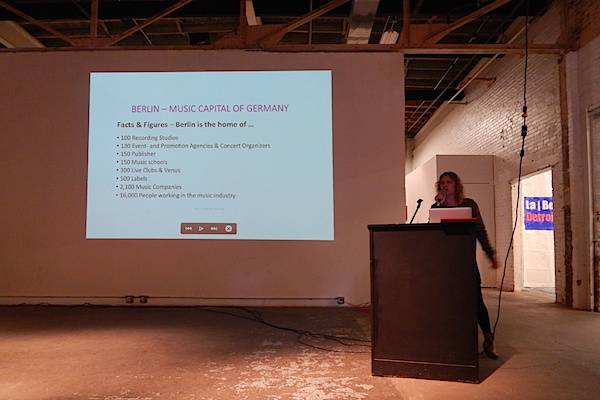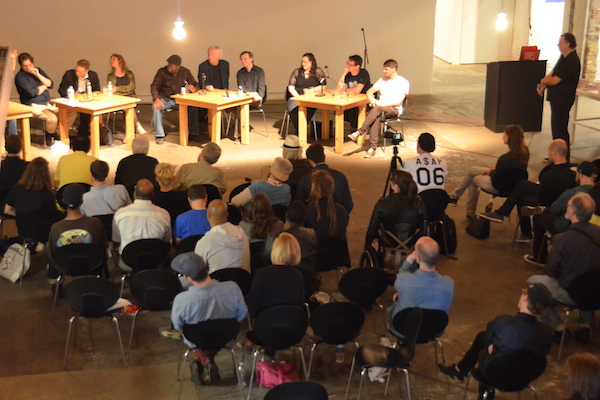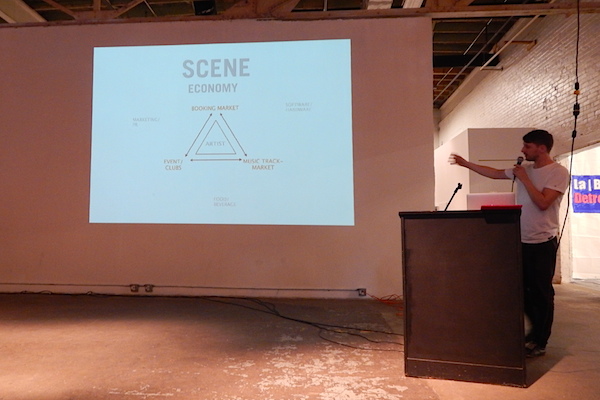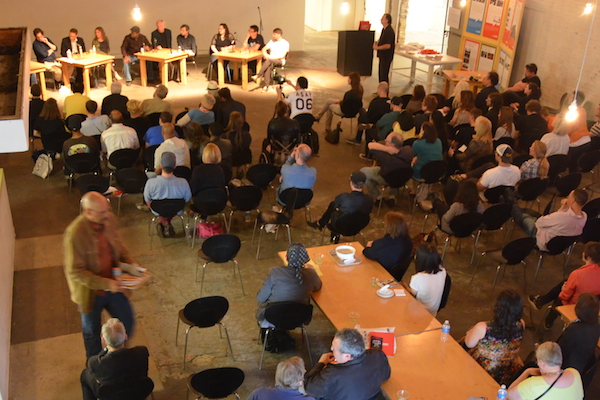Itself a bold experiment in social innovation that brought creative souls together across thousands of miles of land, ocean, and pesky barriers of culture and language, the Detroit-Berlin Connection conference is near-impossible to recap. As a speaker series, that is.
The better way to see this is not as a five-hour "event" on a single day in May at the Museum of Contemporary Art Detroit (
MOCAD), but as a weeklong learning experience based in Detroit with potential to be much longer -- even lifelong. Put some italics around
experience in Detroit. That's what we're talking about here.
I was in the thick of the scheming and programming, which began last December and intensified in the first months of 2014. So I will not pretend to be objective. For that I called upon Ana Cukovic, a specialist in international affairs who studied at the Sorbonne and now does immigration reform work in Detroit and Hamtramck. Ana photographed, live-Tweeted and paid rapt attention to all the presentations and discussions. Also assisting was Sebastian Meissner, a Berlin-based artist and audio reporter who was here to do a comprehensive Detroit piece for German National Radio. My dear friends, thank you. The photos accompanying this piece are Sebastian's, Ana's, and mine.
That left me to do what I do best: nothing at all. Well yes, OK, blast, I did introduce the conference, selected and moderated the Detroit panel -- which multiplied, in the excitement of the event, into a 12-member mass of agreement, healthy disagreement, and spirited debate. This is called, by Andy Warhol's famously charitable definition, "work." But from the point of view of the "worker" it is really just talking, listening, meeting people, finding common ground and closeness -- not to mention several European double-cheek swoon-producing kisses throughout the week.
Transformational
For most of the Berliners, this was a first ever visit to Detroit. Introduction to the city was harsh for some, mainly because basic transportation from airport to city sucks -- it sucks real bad. No train, erratic shuttles, and slightly less erratic but much higher-priced taxis meant that personal drivers were needed at odd hours. That typically isn't news, of course, but when you are on a time and money budget attempting to produce an event of (hoped-for) international significance, it becomes part of the conversation.
But it might also be the perfect way to meet Detroit head on. The city challenges its visitors in ways few others can match. Transportation fail is high on the list. If you can overcome that, and all did, it feels like victory.
Later, you get a bike or set off on foot, begin to navigate the streets near the hotel (most stayed at the
Inn on Ferry Street), and buy
Detroit Denim and other local gear. Within two days or less, you're hanging out with Underground Resistance in the parking lot at Whole Foods or evading security hacks while stomping around the ruins at the Packard Plant. Detroit begins to melt and yield rare treasures before your pretty central European eyes.

The sharpest observations came first from Katja Lucker, who represents
Music Board Berlin, an innovative group that taps into the innovative nature of popular culture itself to keep music discourse lively and productive across Germany; and then from Max Dax, a writer and editor-in-chief of
Electronic Beats magazine.
It was Katja who, talking to me and others from the Berlin team, branded Detroit as a "healing place" where "nature has asserted itself" into the fabric of urban life. From the L-shaped porch fronting one of the historic houses that make up the Inn on Ferry, she talked about the vibrant overgrowth, the "ever-present green" of the city (Incidentally, she and others adored sitting on the porches, which they say don't exist in Berlin) that had a calming effect on everyone.
Dax also talked about nature but more in terms of the "space" that it allows for creative growth. He also pondered how space and the rhythm of life in Detroit (akin to the rhythms found in the hotter climates of the American South and places in the southern hemisphere) may have contributed to the city's rich music culture.
 Conference highlights: Berlin presents
Conference highlights: Berlin presents
While I pondered along with Dax and Lucker, and later guided the panel into exploring "the poetic, the lyrical" qualities -- ingredients that Dax said can lead to a "creative revolution" -- Detroit shares with Berlin, Ana and Sebastian documented. Here are some highlights:
Jennifer Dautermann, a Detroit native who currently resides in Berlin, presented three projects:
WOMEX, ClassicalNEXT, and
C3 Festival. The energy of the presenter was very much in sync with ongoing and exciting projects that both Detroit and Berlin are undertaking. Dautermann’s videos showed artful combinations of live performance and electronic music. She said that the C3 (Club Contemporary Classical) festival should be held in Detroit and that this city, whether we know it or not, has artists who produce such type of music. She also called for collaborators and participants to bring this event here.
Katja Lucker said that before Music Board Berlin launched, the police would often shut down techno parties. The solution, in her view, was to bring the club owners, promoters, studios, and musicians together in establishing an organized voice that would participate in a Berlin senate, thus "bringing the party" into the public sphere.
Music Board Berlin is a tool that promotes, protects, and serves Berlin's vast and expanding pop culture. It funds various music projects and encourages musicians to come to Berlin, particularly by providing resources, programs, and innovative branding of the city. Music Board Berlin has some similarities to Detroit's
D:hive, in terms of being the gateway point for newcomers and those seeking to enter a particular industry or develop an entrepreneurial project. Lucker also spoke of an upcoming festival that is being organized in Berlin that would showcase creative projects that Music Board Berlin represents.
Newthinking is a project that blends media and technology with society and culture to create successful and innovative communities. Presenter Andreas Gebhard stressed stepping out of one's bubble in organizing events that one would personally want to attend, but more importantly, establishing ownership and in turn social responsibility.
Gebhard talked about the Global Innovation Gathering
(GIG), which took place in early May in Berlin and featured social innovators from the fledgling African continental start-up scene. In his discussion of the upcoming
Torstfrazen Festival (August, in Berlin), Andreas stressed the importance of breaking down barriers between the natives of a given city and the incomers (yup/hipsters) in order to cement sustainable growth and collaboration.
Presenter Lutz Leichsenring of the Berlin
Club Commission showed charts that underscored just how much mental muscle Berlin puts into administrating and documenting its pop cultural assets. An illustration of the city's "scene economy" -- which measures in detail how much money is generated in clubs and other performance venues -- was a revelation. To our knowledge, no North American city has even come close to doing this.

Bringing together economic growth and development strategies with popular culture expansion -- with the artist, the most critical piece of the puzzle, in the center of the graph -- is simply brilliant and is a great way of connecting the city with its stakeholders, producers, and consumers.
Leichsenring's presentation also factored in food, drink, and other retail vendors that contribute to Berlin's scene economy. Fantastic stuff to chew on, and absolutely applicable to the growth and development scene in Detroit.
Mario Husten of
Holzmarkt spoke about citizen engagement and responsibility, which is created through participation in cooperative ventures. He, both throughout the presentation and panel discussion, stressed the importance of mere doing -- actions that facilitate creation regardless of hurdles set by the authorities, infrastructure, or finances.
Husten and his Holzmarkt team designed and built a community on the banks of the Spree River without permission from Berlin city authorities. Look at this
rendering. It's an amazing outsider social-art experiment in living and a rejection of all potential government subsidies (which Berlin is swimming in, getting 10 times the amount of state funding than Hamburg, Germany's second largest city).
Opening the invitation to internationals and providing them with tools to actually come to Detroit was another point of discussion, including collaboration with the auto industry, airlines, and other transportation companies. (Editor's note: Husten said we should stop complaining about Detroit transportation woes and do something about it ourselves. Direct flights from Detroit to Berlin? Yes, why not, he said. Build critical mass, put pressure on the airlines and make it happen.)
Max Dax was the best storyteller of the Berlin presenters. He wandered the open spaces he was so was drawn to and wrote down fresh observations of the city -- it was his first visit to Detroit -- in the days prior to the conference. His talk was filled with references to the aforementioned poetry, lyricism, sublime rhythms, and potential for creative revolution.
Dimitri Hegemann called his presentation "The Power of Forgotten Places," an inspired look at neglected, abandoned, and unused spaces resulting in visionary transformation for public use. After spending time in Detroit last winter and again in May, Hegemann's conclusion was that Detroit had the infrastructure to build a global pop culture economy around already existing music, art, and food scenes.
"Detroit is much farther along than many people thought. If we were to put 50,000 people into the mix the difference would become apparent to the world." The next step is a Move to Detroit initiative, he said, to invest and grow what is already here. Stay tuned for some forthcoming projects.
 Conference highlight: Detroit discusses Berlin
Conference highlight: Detroit discusses Berlin
Martina Guzman's 2011 report for National Public Radio,
The Detroit Berlin Connection, was the catalyst for the current project. Guzman kicked off the conference with an overview of the report, which used the two cities' shared interest in Detroit techno as a basis for inspiration, friendship, and creative partnership.
Guzman later sat down with fellow Detroiters Mike Huckaby, Cornelius Harris, Francis Grunow, and Dominic Arellano, who were also joined by all seven presenters from Berlin.
The discussion was honest and direct, with all panelists eager to participate. Microphones passed quickly, ideas swirled even faster.
The topic of Detroit's "space" -- physical, psychological, psychogeographical -- was tossed out to the panel. There was a general consensus among the Germans that space in Detroit and space in Berlin today are largely incomparable. Dax said the Berlin of the early-1990s and present-day Detroit can be compared, but Berlin in 2014 is a city of decreasing space for creativity while Detroit has space in abundance.
When the notion of space as a Detroit asset was suggested, Husten said space "must never be thought of as an asset." To do so was to set dangerous precedents, he said, making something that should be shared by everyone into something owned and administrated by a few.
Space segued into discussion of infrastructure, which brought out multiple points of view, definitions, and opinions. While there was some consensus among the Berliners that infrastructure had hit near rock bottom by time of the fall of the Wall in 1989, Dautermann said that from her perspective as a native Detroiter and transplant to Berlin in the mid-1990s, even at its worst the infrastructure there was still far superior to Detroit's.
Grunow said it depended on what kind of infrastructure we were talking about: in terms of freeway building and water and sewerage, Detroit was among the national leaders in the U.S.
Aside from infrastructure in the literal sense, Harris talked about the social disparities that are part of the Detroit experience.
"There are day to day problems that have to be overcome in just living here. Transportation is just one of many things," he said. "There are two Detroits. A majority of the city wouldn't even know what we're talking about. The kids don't know a thing about Berlin and how people there are inspired by what we do."
The discussion ended with a consensus view that the conversation was just beginning. Certain aspects of Detroit and Berlin were demystified and demythologized -- necessary to ground a most ambitious project in reality --while the promise of continued friendship and hard work together seemed to sink in for all.
We talked about expanding the conference to two days in the future, and of bringing a Detroit panel to Berlin. Then we acted on an impulse well known to most Detroiters and Berliners and headed for some food and drink, with a weekend of Movement and related parties looming for dessert.
Walter Wasacz is a former managing editor for Model D and a consultant for the Detroit-Berlin Connection. Expect updates on the projects in the months to come.
Photos by Ana Cukovic, Sebastian Meissner and Walter Wasacz